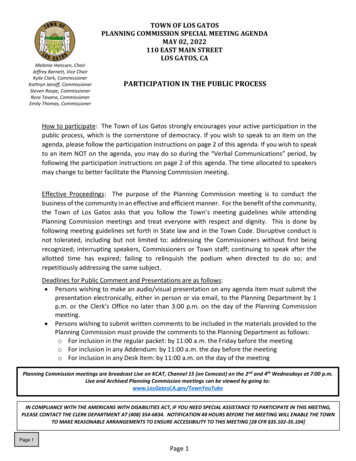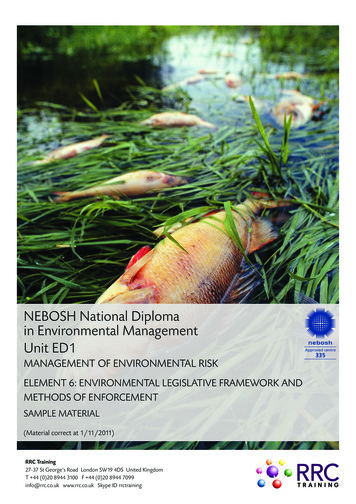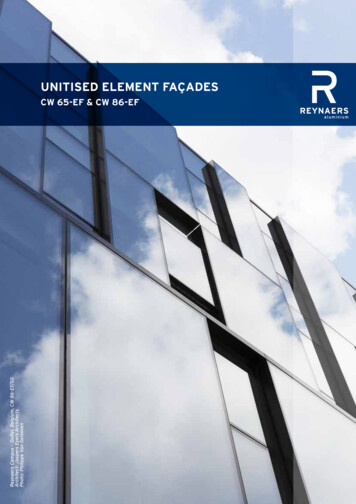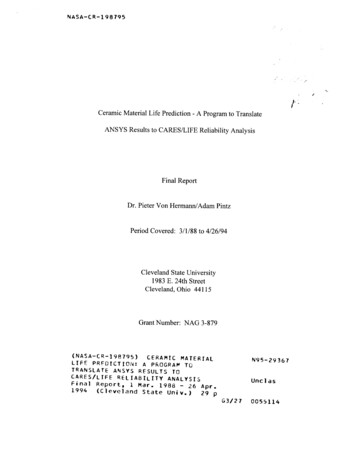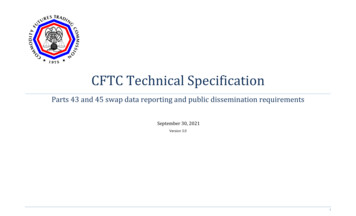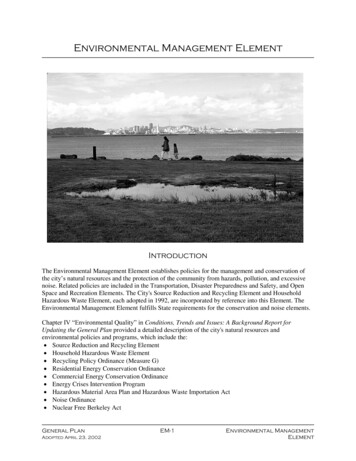
Transcription
Environmental Management ElementIntroductionThe Environmental Management Element establishes policies for the management and conservation ofthe city’s natural resources and the protection of the community from hazards, pollution, and excessivenoise. Related policies are included in the Transportation, Disaster Preparedness and Safety, and OpenSpace and Recreation Elements. The City's Source Reduction and Recycling Element and HouseholdHazardous Waste Element, each adopted in 1992, are incorporated by reference into this Element. TheEnvironmental Management Element fulfills State requirements for the conservation and noise elements.Chapter IV “Environmental Quality” in Conditions, Trends and Issues: A Background Report forUpdating the General Plan provided a detailed description of the city's natural resources andenvironmental policies and programs, which include the: Source Reduction and Recycling Element Household Hazardous Waste Element Recycling Policy Ordinance (Measure G) Residential Energy Conservation Ordinance Commercial Energy Conservation Ordinance Energy Crises Intervention Program Hazardous Material Area Plan and Hazardous Waste Importation Act Noise Ordinance Nuclear Free Berkeley ActGeneral PlanAdopted April 23, 2002EM-1Environmental ManagementElement
The City has adopted: The Joint Watershed Goals Statement with the cities of Albany, El Cerrito, and Richmond The City of Berkeley Resource Conservation and Global Warming Abatement Plan, which identifiesactions necessary to achieve a 15% reduction in emissions by the year 2010 (a 129,000-metric-tonreduction) The Valdez Principles The Green Business Program The Environmental Economy Program The Green Building InitiativePolicy BackgroundAlthough Berkeley consists largely of urbanized, developed land, it does offer a great variety andabundance of natural resources and open space areas in the form of lush landscaping and urbanvegetation, waterfront habitat along the shoreline, and wooded areas in the hills. The city also boasts anetwork of urban creeks descending from the hills to San Francisco Bay. Due to its long-establishedurbanized character, Berkeley has no active timber harvesting, mineral extraction, or fish and gameindustries. Agriculture in Berkeley is limited to personal and community gardens. Some fishing forpersonal use takes place at the Berkeley Marina, but commercial fishing operations are limited torecreational fishing charter boats.Solid and Hazardous WastesBerkeley has a long history of concern for the environment, and in particular an interest in andcommitment to reducing the amount of materials entering the solid waste stream. In compliance withState law, Berkeley adopted a 64% waste diversion goal through a Source Reduction and RecyclingElement (SRRE) prepared pursuant to the California Integrated Waste Management Act. Although theCity’s goal of 64% exceeds the State-mandated 50% goal, Berkeley is currently diverting about 43% ofits waste stream. Some of Berkeley’s solid waste programs are privately operated, entirely independent ofthe public sector; some are privately owned but supported in one way or another by government; andsome are conducted entirely by government entities. Solid and hazardous waste programs include:Curbside Residential RecyclingCommercial RecyclingOrganic Materials CollectionCertified Unified Program Regulation ofHazardous Materials and HazardousWaste Oil Recycling ProgramAsbestos Abatement ProgramRecycling Market Development ZonePolystyrene and Styrofoam banCommunity Conservation Centers’ Drop-Offand Buyback ProgramConstruction/Demolition Materials RecyclingTransfer Station Operation and RecyclingUsed Motor Oil RecyclingAnnual Neighborhood CleanupIllegal Dumping Collection and Bulky GoodsCollectionCoolants and Oils RecyclingOrganic Materials CollectionStreet Tree Wood Waste Recycling ProgramEnergyThe Berkeley community has also long been concerned about and involved with energy issues. In keepingwith its progressive tradition, the City’s efforts in planning and implementing energy conservationmeasures were among the first in the nation. Although recent energy usage figures show the community’sGeneral PlanAdopted April 23, 2002EM-2Environmental ManagementElement
overall usage has declined in recent years, the long-term success of the City’s energy programs willultimately depend upon the community’s ability to change its behavior patterns.Green BuildingBuildings consume 40% of the world’s total energy and materials, 25% of the wood harvested, and 17%of the potable water. “Green” building practices can reduce these environmental and human healthproblems. A green building is sited, designed, constructed, and operated to enhance the well-being of itsoccupants, and to minimize the negative impacts on the community and the natural environment. In recentyears, Berkeley has developed a Green Building Initiative, which seeks to make building green the“business as usual” choice for new construction and major remodel projects in Berkeley.Streets, Sewers, and Essential InfrastructureIn recent years, there has also been growing concern about the state of Berkeley’s essential infrastructurebecause of years of deferred maintenance, and the impact of that infrastructure on the environment. TheCity’s 5-year Capital Improvement Program totals 137 million in funding for capital improvements for2002 to 2006, many of which are infrastructure improvements. The improvement of the City’s sewersystem accounts for 39 million of the Capital Improvement Program budget, streets account for 25million, and parks and waterfront improvements account for 16 million. A continued commitment toupgrading and maintaining the City’s essential infrastructure will be essential to the health and vitality ofthe community and the environment for current and future generations. Figure 19 shows in dark lines theportions of Berkeley’s sewer system that have been upgraded.Figure 19: Sewer System ImprovementsGeneral PlanAdopted April 23, 2002EM-3Environmental ManagementElement
Creeks and WatercoursesThe City of Berkeley contains five principal creeks: Derby, Potter, Strawberry, Schoolhouse, andCodornices, all of which flow west from the Berkeley Hills into San Francisco Bay. In addition, eightother creeks are at least partially within the City limits. Prior to urbanization, Berkeley's creek systemprovided a rich riparian habitat for aquatic and terrestrial plant and animal life. The natural watercoursesminimized erosion, handled floodwaters, contributed to groundwater reserves and moderated temperatureextremes. Most of the creeks in the flatlands are contained within underground drain culverts, a notableexception being Codornices Creek. In hillier areas, the creeks remain largely aboveground except understreets. In recent years, there has been a movement to attempt to "daylight" these underground creeks toonce again flow aboveground. As a first effort, a 200-foot stretch of Strawberry Creek was opened in theCity's Strawberry Creek Park. More recent examples are the block of Codornices Creek between Eighthand Ninth Streets, and Blackberry Creek in the Thousand Oaks School Park. Figure 20 illustrates thegeneral location and condition of each of the city’s major creeks.In 1989, the City of Berkeley passed Ordinance No. 5961, entitled Preservation and Restoration ofNatural Watercourses. The purposes of the ordinance are to regulate any future culverting of orconstruction in open creeks, to encourage the rehabilitation and restoration of natural waterways, and topromote responsible management of watersheds. Among the provisions of the ordinance are prohibitionsagainst obstructing or interfering with watercourses; required setbacks for new construction; andrequirements for obtaining of permits for construction of walls, drains, and bulkheads.Figure 20: Berkeley CreeksGeneral PlanAdopted April 23, 2002EM-4Environmental ManagementElement
Trees and the Urban ForestThe City has an extensive public street tree program. The Parks and Waterfront Department maintains30,000 street trees and 5,000 trees in the City's parks. Under the City's Tree Planting Program, the Cityplants up to 600 trees for city residents at no cost to the resident other than an agreement by the residentto water the tree. Most of the city's street trees are typically located in a three- to four-foot-wide grassyplanting strip alongside the sidewalk. The City is currently on a five-year pruning cycle designed toensure that every tree is pruned at least once every five years. Herbaceous and shrub vegetation is plantedalong with street trees in medians along many of the city's major roadways.An inventory of Berkeley's street trees in the late 1980s found the following tree species to be mostabundant in Berkeley:Sycamore, London Plane (Platanus acerifolia)Plum, Purple Leaf (Prunus cerasifera)Liquidambar (Liquidambar styraciflua)Camphor (Cinnamomum camphora)Elm, Chinese (Ulmus parvifolia)Cherry, Oriental (Prunus serrulata)Pittosporum, Victorian Box (Pittosporumundulatum)]Ash, Shamel (Fraxinus uhdei)Elm, English (Ulmus procera)Ash, Modesto (Fraxinus velutina glabra)Most of the above-listed species are not native to the Berkeley area, but do well in the Mediterranean-typeclimate and have characteristics suitable for street trees.In 1990, the City of Berkeley adopted a Tree Policy. The goal of the Tree Policy is to care for andmaintain the trees growing in the parkways and parks in the city. The Policy sets forth specific guidanceon tree species criteria and tree selection, planting methods, consideration of views, agreement withneighboring property owners regarding continued watering, tree replacement, emergency tree work, andtree protection and care.Air QualityIn contrast to some areas of the Bay Area Air Basin, air quality in Berkeley generally meets clean airstandards on most days. Air quality concerns that do occur in Berkeley are more related to aircontaminants for which there are no established safe standards. These contaminants include airbornecarcinogens and nuisance sources, such as odors or dust. While the meteorology is generally favorable forminimizing air pollution, the Berkeley area is a source region for air quality problems in downwindcommunities. This impact is exacerbated by the frequent traffic congestion in Berkeley. Consequently,emission reductions in Berkeley will have a limited local benefit, but will be an important contributor toattaining/maintaining clean air standards in the region.Transportation is the major contributor to regional air pollution. Stationary sources (e.g., smokestackindustries) were once important sources of both regional pollution as well as a local nuisance. Their rolein the pollution picture--regionally and locally--has been substantially reduced in recent years bypollution control programs of the Bay Area Air Quality Management District (BAAQMD). Any furtherprogress in air quality improvement now focuses heavily on the automobile.NoiseMajor noise sources in Berkeley include cars, trucks, buses, trains, industrial plant equipment noise, andactivities associated with neighborhoods and schools (lawn mowing and leaf blowing, children playing,General PlanAdopted April 23, 2002EM-5Environmental ManagementElement
etc.). The most important difference between transportation and non-transportation noise sources is thatthe City can generally exercise control on the level and duration of noise at the property line of a nontransportation source of noise. Cities adopt noise exposure standards for noise levels generated frommobile sources, such as trucks, trains, or planes, and then make permitting decisions for land usesregarding their sensitivity in areas with excessive noise. Cities play a role in enforcing the requirement inthe State Vehicle Code regarding properly operating mufflers, and may also set speed limits or weightrestrictions on streets. In general terms, a city’s actions are primarily proactive with respect to stationarynoise sources versus reactive for those mobile sources beyond city control.Figure 21, Noise Contours, shows the general noise levels throughout the city. The contour lines representaverage Day-Night levels (Ldn).Figure 21: Noise ContoursNoise measurements taken at many locations throughout the city have shown that overall noise levelshave remained fairly constant in Berkeley over the last 20 years. Figure 21 depicts the general level ofGeneral PlanAdopted April 23, 2002EM-6Environmental ManagementElement
noise that can be expected on any given day. Comprehensive noise measurements were taken throughoutthe city in 1973 and 1995. Small decreases in noise levels have occurred along much of San PabloAvenue and along portions of Ashby Avenue since 1973. Some increases in noise levels have beenobserved along a number of roadways, including portions of Sixth Street, Martin Luther King Jr. Way,Milvia Street, Shattuck Avenue, Oxford Street, Claremont Avenue, Grizzly Peak Boulevard, GilmanStreet, Hopkins Street, Delaware Street, Hearst Avenue, and Dwight Way. These changes are consistentwith the recent citywide traffic counts which show that although traffic has increased on some streets,actual traffic volume and traffic speeds have lowered on other streets, which would result in a reduction innoise levels. However, a closer comparison of the two studies shows that the recorded differences mayinstead be due to slight differences in how the measurements were taken or the particular conditions onthe day the measurements were taken.Noise sources related to heavy manufacturing, located mainly in industrialized West Berkeley, were oncea more dominant contributor to the noise environment. In the past, noise-related land use conflictsbetween West Berkeley and other more residential sectors of the city were at a minimum, given thedistance between these areas. More recently, however, increased residential and commercial uses in WestBerkeley have begun to threaten industrial uses, in part through a changing perception of environmentalstandards as they relate to the manufacturing process. The presumption in the past in most industriallyzoned areas was that noise generated by an industrial use was an acceptable part of the manufacturingcontext. The Concept Plan for West Berkeley was adopted in 1991 and included policies to address thesetypes of noise conflicts in order to maintain the historic mix of land uses in an environmentallyresponsible manner. The West Berkeley Plan, adopted in 1993, calls for more stringent environmentalreview and regulation, including the mitigation of noise through both industrial and residential measures.The City’s Noise Ordinance sets limits for permissible noise levels during the day and night according tothe zoning of the area. The Noise Ordinance does not recognize residents living in non-residential zones,such as in West Berkeley. In addition, if ambient noise (the general level of noise in the area) exceeds thestandard, that ambient noise level becomes the allowable noise level. Enforcement of the Berkeley NoiseOrdinance (Chapter 13.40 of the Municipal Code) is often related to commercial or industrial mechanicalequipment that is sited near residential uses.Element ObjectivesThe policies and actions of the Environmental Management Element are intended to make Berkeley amore environmentally sustainable community by achieving the following eight objectives:1. Promote development and coordination of local and regional environmental management programs andfacilitate community participation in environmental protection and conservation.2. Reduce solid and hazardous wastes and minimize risk from hazardous materials.3. Reduce emissions and improve air quality.4. Conserve water, improve water quality, and facilitate creek restoration.5. Protect, maintain, and enhance the urban forest (including street and park trees) and natural habitatareas.6. Support and promote a local food system based upon sustainable regional agriculture to assure accessto healthy, affordable, and culturally appropriate foods.General PlanAdopted April 23, 2002EM-7Environmental ManagementElement
7. Reduce nonrenewable energy consumption and unnecessary glare from inappropriate lighting.8. Protect the community from excessive noise levels.Policies and ActionsEnvironmental Management ProgramsPolicy EM-1 City of Berkeley LeadershipMaintain Berkeley's position as a leader in the adoption and implementation of environmentalmanagement programs.Actions:A. Consider environmental and social costs in all decision-making and budget decisions.B. Ensure full disclosure of information about environmental consequences of City decisions.C. Continue to develop and use scientifically based environmental management principles to informdecisions regarding economic, social, and physical planning.D. Coordinate City regulatory and educational functions to facilitate environmental management goals.E. Adopt a comprehensive Environmental Leadership policy to integrate environmental policies andcommunicate the City's Environmental Leadership Mission to the public.Policy EM-2 Sustainable BerkeleyMaintain Berkeley’s position as a leader in the creation and implementation of sustainable communitypractices and programs.Actions:A. Ensure that City activities are accomplished in a coordinated way, governed by our overarching goalof sustainability.B. Align City mission statements, budgeting, and operations with sustainability goals. Considersustainability criteria in City policy, City purchasing, municipal operations, and program decisions.C. Consider establishing a coordinating body to spearhead and accelerate organizational and communityimplementation of sustainable practices and to ensure integration of environmental, economic, andsocial policies and programs.D. Report progress on sustainability goals regularly as part of the General Plan Annual Review. Conducta Sustainability Assessment using the activity to set targets to meet goals and monitor future action.E. Obtain certification as a sustainable municipal operation.F.Promote the adoption of sustainable activities by the public, businesses, and organizations.General PlanAdopted April 23, 2002EM-8Environmental ManagementElement
Policy EM-3 Regional CoordinationPromote the City's environmental management and sustainability policies and programs and encourageother cities in the region to establish similar or better policies and programs.Actions:A. Coordinate Berkeley's sustainability and environmental management programs with other, relatedprograms in the region.B. Support regional efforts to create economic incentives to encourage environmental management andsustainability by cities, businesses, and households.C. Support public-private environmental management and sustainability partnerships with the scientific,environmental, educational, and business communities to develop sustainable applications for publicand private use and to implement educational programs for households, public agencies, andbusinesses.EM-4 Green Building CertificationDevelop a green building certification program.Actions:When developing the program consider:A. Requiring City-owned buildings, buildings developed by private developers on City-owned andcontrolled land, and projects that include City financial assistance to be Green Building certified.B. Encouraging all private buildings to be Green Building certified.C. Developing a green design assistance program.D. The minimization of greenhouse gases produced by new buildings especially as related to spaceheating efficiencies.Policy EM-5 “Green” BuildingsPromote and encourage compliance with “green” building standards. (Also see Urban Design andPreservation Policy UD-33.)Actions:A. Encourage, and where appropriate require, new construction and major remodel projects to be sited,designed, constructed, and operated to enhance the well-being of their occupants, and to minimizepresent and future impacts on the community and the natural environment. (Also see Policy EM-39.)B. Encourage landscaping for water and energy efficiency. (Also see Policy EM-26.)C. Encourage buildings to incorporate renewable energy and energy- and water-efficient technologies.(Also see Policies EM-38 and EM-39.)D. Encourage use of recycled-content construction materials. (Also see Policy EM-6.)General PlanAdopted April 23, 2002EM-9Environmental ManagementElement
E. Encourage efforts to improve indoor air quality and to provide a comfortable and healthyenvironment.F. Encourage reduction of construction and demolition waste. (Also see Policy EM-6.)G. Encourage construction of durable buildings.H. Establish a green design assistance and green building certification program.Policy EM-6 Nuclear Free BerkeleyContinue to enforce the provisions of the Nuclear Free Berkeley Act. The City shall not invest in orcontract with entities that are engaged in Nuclear Weapons work, except under the limited circumstancesoutlined in the Act. The City shall provide timely notice of proposals to waive the Nuclear Free Act, sothat citizens are assured the opportunity to comment on any proposed waiver of the Nuclear Free Act. Itshall therefore be City of Berkeley policy that the City supports First Amendment actions to defend theBerkeley Nuclear Free Act.Solid and Hazardous Waste and RegulationsPolicy EM-7 Reduced WastesContinue to reduce solid and hazardous wastes.Actions:A. Achieve a 64% diversion of waste from landfills.B. Manage wastes locally to the greatest extent feasible to minimize the export of wastes and pollutionto other communities.C. Encourage the Lawrence Berkeley Laboratory and the University of California to minimize to thegreatest extent feasible the storage of radioactive and other toxic wastes in Berkeley.D. Encourage reduction in the use of toxic materials.E. Encourage reuse, recycling, and composting.F. Facilitate battery and used oil recycling.G. Support programs and incentives to reduce the manufacture and use of materials which are nonrecyclable or hazardous to people and the environment.H. Develop education and promotion programs to increase recycling by occupants of multi-familybuildings.I.Through legislation and other means, reduce the use of plastic by eliminating multiple layers inpackaging and encourage reusable shipping containers such as collapsible pallets and refillable bottlesfor bulk liquids.J. Encourage reusable bags and packaging such as reusable bottles, whether glass or plastic.K. Link collection of plastic to mandated recycled content in plastic packaging.General PlanAdopted April 23, 2002EM-10Environmental ManagementElement
L. Advocate at the state level for higher disposal fees for products that are designed for single use andfor products that do not incorporate any post-consumer recycled content.Policy EM-8 Building Reuse and Construction WasteEncourage rehabilitation and reuse of buildings whenever appropriate and feasible in order to reducewaste, conserve resources and energy, and reduce construction costs. (Also see Urban Design andPreservation Policy UD-6.)Actions:A. Encourage the reuse of demolition materials and recycling of construction scraps.B. Expand the existing yard-waste recycling program to include restaurant and institutional food waste.Policy EM-9 Recycling and Waste Transfer StationsEnsure convenient access for Berkeley citizens to transfer stations, recycling, composting, and collectionof household hazardous waste products.Action:A. Seek to identify a site for and develop a Berkeley hazardous waste drop-off facility, or develop acitywide pickup program.Policy EM-10 Materials Recovery and RemanufacturingSupport and encourage serial materials recovery and remanufacturing industries. (Also see EconomicDevelopment and Employment Policy ED-7.)Action:A. Consider zoning changes to facilitate relocation and establishment of recovery and remanufacturingindustries.Policy EM-11 Biodegradable Materials and Green ChemistrySupport efforts to phase out the use of long-lived synthetic compounds, such as pesticides and vehicleanti-freeze, and certain naturally occurring substances which do not biodegrade. Encourage efforts tochange manufacturing processes to use biodegradable materials, recycle manufactured products, reuse byproducts, and use “green” products.Actions:A. Encourage citywide efforts to phase out or minimize the use of synthetic fertilizers, hazardoushousehold wastes, toxic cleaning agents, herbicides, and pesticides.B. Require City departments to use nontoxic materials whenever possible.C. Encourage retailers to stock nontoxic alternatives to hazardous products.Policy EM-12 EducationWork with other State and local agencies to educate business owners and residents regarding safe use,recycling, and disposal of toxic materials; reducing hazardous household wastes; and substitutes for thesesubstances.General PlanAdopted April 23, 2002EM-11Environmental ManagementElement
Actions:A. Implement business operator education and hazardous materials minimization programs to avoidaccidental releases of hazardous materials.B. Conduct periodic training exercises for the identification, containment, decontamination, and disposalof hazardous materials.Policy EM-13 Hazardous Materials DisclosureContinue to require the disclosure of hazardous materials usage and encourage businesses using suchmaterials to prepare and implement a plan to reduce the use of hazardous materials and the generation ofhazardous wastes.Policy EM-14 Hazardous Material RegulationControl and regulate the use, storage and transportation of toxic, explosive, and other hazardous andextremely hazardous material to prevent unauthorized and accidental discharges. (Also see DisasterPreparedness and Safety Policy S-14.)Actions:A. Regularly inspect businesses using, storing, transporting, or generating hazardous materials or wastesto ensure compliance with federal, state, and local regulations.B. Require facility operators to write and implement contingency plans in preparation for emergencysituations and accidental releases. Additionally, require facilities to train their employees on how toactivate the contingency plans.Policy EM-15 Environmental InvestigationWhen reviewing applications for new development in areas historically used for industrial uses, requireenvironmental investigation as necessary to ensure that soils, groundwater, and buildings affected byhazardous material releases from prior land uses would not have the potential to affect the environment orthe health and safety of future property owners, users, or construction workers. (Also see DisasterPreparedness and Safety Policy S-15.)Policy EM-16 Risk ReductionWork with owners of vulnerable structures with significant quantities of hazardous material to mitigatepotential risks. (Also see Disaster Preparedness and Safety Policy S-13.)Policy EM-17 Warning SystemsEstablish a way to warn residents of a release of toxic material or other health hazard, such as sirensand/or radio broadcasts. (Also see Disaster Preparedness and Safety Policies S-1 and S-9.)Air QualityPolicy EM-18 Regional Air Quality ActionContinue working with the Bay Area Air Quality Management District and other regional agencies to:1. Improve air quality through pollution prevention methods.2. Ensure enforcement of air emission standards.3. Reduce local and regional traffic (the single largest source of air pollution in the city) and promotepublic transit.4. Promote regional air pollution prevention plans for business and industry.General PlanAdopted April 23, 2002EM-12Environmental ManagementElement
5. Promote strategies to reduce particulate pollution from residential fireplaces and wood-burningstoves.6. Locate parking appropriately and provide adequate signage to reduce unnecessary “circling” andsearching for parking.Policy EM-19 15% Emission Reduction: Global Warming PlanMake efforts to reduce local emissions by 15% by the year 2010. (Also see Transportation Policy T-19.)Action:A. Continue to support and implement local emission reduction programs, such as the City of BerkeleyEmployee Fleet Bicycle Program, the Police Bicycle Program, and the actions recommended in theCity of Berkeley Resource Conservation and Global Warming Abatement Plan.Policy EM-20 City of Berkeley FleetThe City should exceed Federal and State standards for all City fleet vehicles and use all means practicalto reduce emissions of criteria pollutants and greenhouse gases. (Also see Transportation Policy T-11.)Actions:A. Through attrition, eliminate all heavy-duty, diesel-fueled vehicles.B. All vehicle acquisitions should be of a size and fuel-type (including bicycles, ultra-light vehicles,electric vehicles and/or hybrid vehicles, and premium-efficiency conventional vehicles) that areappropriate for the tasks and have the least amount of emissions.C. Continue to convert fleet vehicles to natural gas, electricity, and other alternative fuels. Substitutebicycles for energy-powered vehicles whenever possible.Policy EM-21 Alternative FuelsWork with the University of California, the Berkeley Unified School District, and other agencies toestablish natural gas fueling and electric vehicle recharging stations accessible to the public.Policy EM-22 Public AwarenessIncrease public awareness of air quality problems, rules, and solutions through use of City publicationsand networks.Action:A. Work on a local and regional level to improve air quality for Berkeley residents and the region.Water Quality and CreeksEM-23 Water Quality in Creeks and San Francisco BayTake action to improve water quality in creeks and San Francisco Bay.Actions:A. Work with the East Bay Municipal District (EBMUD) to ensure that wastewater discharges complywith the requirements of EBMUD’s Wastewater Control Ordinance No. 311 to manage wastewatertreatment discharges to protect San Francisco Bay.General PlanAdopted April 23, 2002EM-13Environmenta
The City's Source Reduction and Recycling Element and Household Hazardous Waste Element, each adopted in 1992, are incorporated by reference into this Element. . network of urban creeks descending from the hills to San Francisco Bay. Due to its long-established . An inventory of Berkeley's street trees in the late 1980s found the following .

